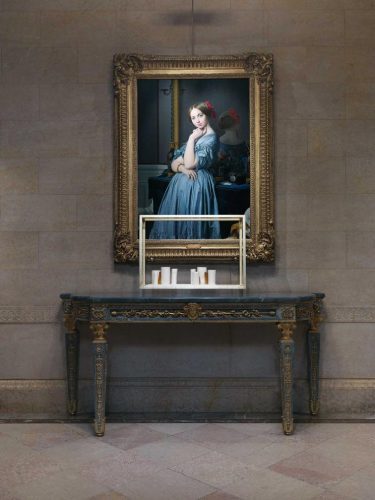
Edmund de Waal, that pause of space, porcelain, gold, alabaster, aluminum, and plexiglass, on view in the North Hall (photo by Christopher Burke)
The Frick Collection
1 East 70th St. at Fifth Ave.
Moroni through June 2, de Waal through November 17, $12-$22
212-288-0700
www.frick.org
The brief confluence of two shows at the Frick, “Elective Affinities: Edmund de Waal at the Frick Collection,” which opened May 30, and “Moroni: The Riches of Renaissance Portraiture,” which closes June 2, offers an unexpected, unanticipated bonus. For “Elective Affinities,” author and ceramicist Edmund de Waal has created site-specific vitrines of objects made of porcelain, steel, gold, alabaster, and aluminum and placed them throughout the museum, interacting with individual paintings, sculptures, and furniture, resulting in intriguing dialogues involving form, shape, color, balance, and space while exploring such concepts as wealth, power, elegance, and industry. The Moroni show focuses on the Italian painter’s portraits, many of which are accompanied by vitrines of objects relating to elements found in the work. De Waal’s an alchemy is embedded in the bottom of a table on which resides André-Charles Boulle’s “Barometer Clock,” John C. Johansen’s portrait of Henry Clay Frick looming in the background; below Jean-Auguste-Dominique Ingres’s Comtesse d’Haussonville is sub silentio, which dramatically interacts with the painting’s composition; and the temptation of Christ on the mountain echoes the architectural structures in Duccio di Buoninsegna’s tempera on poplar panel depiction of Satan attempting to entice Jesus to the dark side. A mid-sixteenth century rapier stands by Moroni’s Gabriel de la Cueva, a sword on the subject’s left side; sixteenth-century shears hover by The Tailor, in which a man is cutting fabric; and a bejeweled “Marten’s Head” resembles one of the precious accessories adorning the portrait of Isotta Brembati. Each of the exhibitions is worth seeing on its own merits, but for a few days, they can be experienced together in an unintended yet fascinating way, in lovely dialogue with each other.